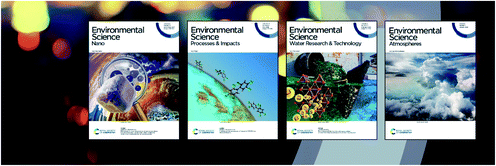 Open Access Article
Open Access ArticleCreative Commons Attribution 3.0 Unported Licence
Environmental Science: Atmospheres joins the Environmental Science journal family
Abstract
Molecules in the atmosphere: a question of scales.
Introduction
We are delighted to present you with the inaugural issue of Environmental Science: Atmospheres a new gold open access journal published by the Royal Society of Chemistry with the Article Processing Charges waived until mid-2023. Environmental Science: Atmospheres joins our Environmental Science journal family covering nanomaterials for environment-based applications (ES: Nano), water research (ES: Water Research & Technology), and all areas of the environmental chemical sciences (ES: Processes & Impacts).The journal was launched to provide the community with a venue dedicated solely to publishing high-impact research in the interdisciplinary field of Atmospheric Science. Its mission is to bridge fundamental and applied research, bringing together different communities, facilitating communication between them, and inspiring new ideas.
Scope
Environmental Science: Atmospheres is truly cross-disciplinary and spans the entirety of Earth’s atmosphere including research in atmosphere–biosphere, atmosphere–ocean, and atmosphere–surface interactions, as well as indoor air and human health effects. All aspects of science are covered, including in situ and laboratory measurements, computational chemistry and modelling, instrumentation, and remote sensing.The Editor-in-Chief of Environmental Science: Atmospheres is Neil M. Donahue, the Thomas Lord University Professor of Chemistry in the Departments of Chemistry, Chemical Engineering, and Engineering and Public Policy at Carnegie Mellon University, where he directs the Steinbrenner Institute for Environmental Education and Research. In the following he offers his perspective on the journal scope and mission and his ambitions for the journal.
“The atmosphere is teeming with molecules, and understanding the behaviour of those molecules in the atmosphere is the central theme of Environmental Science: Atmospheres. Behaviour includes sources, transformation, and sinks. It thus includes interaction between the atmosphere and other biogeochemical reservoirs: the ocean, the land surface, and the biosphere on land and sea. The past decade or so has seen tremendous advances in instrumentation as well as computing power. This means we can now detect many key molecules and radicals in the atmosphere – in the gas phase, in particles, and in cloud droplets – that until recently were far beyond our analytical reach. These measurements can be carried out widely, often in situ and in real time. Concurrently, the chemical complexity of the molecules we can measure has expanded enormously, and so the measured information (for example count rates and a chemical formula) is often incomplete. These more complex molecules have reliably shown the capacity to surprise; received wisdom about their behaviour often falls short. One example is the emergence of autoxidation involving peroxy-radical isomerization and oxygen atom addition. Fortunately, computational chemistry is approaching chemical accuracy (energies within a few tenths of a kilojoule per mole) for even modestly large open-shell molecules. Consequently, computational chemistry can and does guide our understanding of these otherwise inscrutable signals. Numerous other methods are enabling measurements with unprecedented sensitivity and size and spatial resolution. This includes satellite-based remote sensing with global coverage and high spatial resolution and sensitive measurements on aerosol surfaces.
Atmospheric chemical processes are central to some of the largest uncertainties in our understanding of Earth’s climate system. Aerosol health effects are fundamentally driven by inhalation of chemical toxicants – most of which are products of atmospheric chemistry in the aerosol phase – and of course, the SARS-CoV-2 virus spreads via respiratory aerosols, subject to atmospheric dispersion and chemical processing. Atmosphere–ocean interactions are especially important to Environmental Science, as are topics such as particle formation in the marine atmosphere, which not only covers almost four-fifths of the planet but provides very high contrast between white clouds and the dark ocean in regions where cloud microphysics are often highly sensitive to total particle number and size distributions. The “atmosphere” in the journal title is not restricted to Earth. Detailed observational constraints are emerging for planetary atmospheres within the Solar system and even beyond, and understanding chemical behaviour in these atmospheres is highly complementary to understanding chemistry in Earth’s atmosphere.
All of these advances herald an era of profound advances in our fundamental understanding of atmospheric behaviour, and our goal at Environmental Science: Atmospheres is to be the home for reports describing many of these exciting advances in the coming years. We will emphasize high-quality, generalizable and fundamental science delivered with high-quality writing, so that our papers are uniformly educational, insightful, and a joy to read.”
Transparent peer-review
We at the Royal Society of Chemistry care deeply for openness and transparency, thus our authors are offered a Transparent Peer-Review option which gives them an opportunity to publish the full peer-review record associated with their manuscript, including editorial decision letters, peer-reviewer comments and author responses to reviewers and editors. Authors are able to opt in to transparent peer-review on two stages: upon submission and upon revision. The peer-review record does not include confidential comments to the editors and third-party information.Reviewers are informed explicitly that if the authors decide to opt in to transparent peer-review their comments will be published along with the manuscript. Although their reports are publicized reviewers remain anonymous by default unless they choose to sign their review.
Opening up the peer-review makes the decision-making process more transparent, and the editors can be held accountable for their decisions. This increases the potential to advance research integrity and reproducibility and helps prevent research manipulation and fraudulent review. In adopting transparent peer-review, we are taking a step towards supporting increased openness, accountability and trust in the publishing process.
Conclusions
We hope that you will enjoy reading the first issue of Environmental Science: Atmospheres. There are some trending topics in Atmospheric Chemistry covered, such as evolution of BBOA, WSOC and SV-OVOC. We will strive to retain this quality level in the future and invite you to help us build this journal by joining our upcoming initiatives.We are very grateful to the many people who have contributed to the launch of Environmental Science: Atmospheres, particularly the Editorial Board members, who have provided invaluable support and enabled the journal to start off strongly. In addition, we immensely value our authors, reviewers and readers. You all are pivotal in the success of Environmental Science: Atmospheres!
Finally, we are committed to developing and taking Environmental Science: Atmospheres forward so that the journal fully meets the needs of our authors and readers. We always welcome comments, suggestions, and feedback, so please do contact us at E-mail: esatmospheres-rsc@rsc.org with your views and feedback. You can also follow us on Twitter or Facebook, or sign up to our newsletter to keep up to date with the latest news and some of our most recently published content.
Professor Neil M. Donahue, Editor-in-Chief
Dr Anna Rulka, Executive Editor
| This journal is © The Royal Society of Chemistry 2021 |


